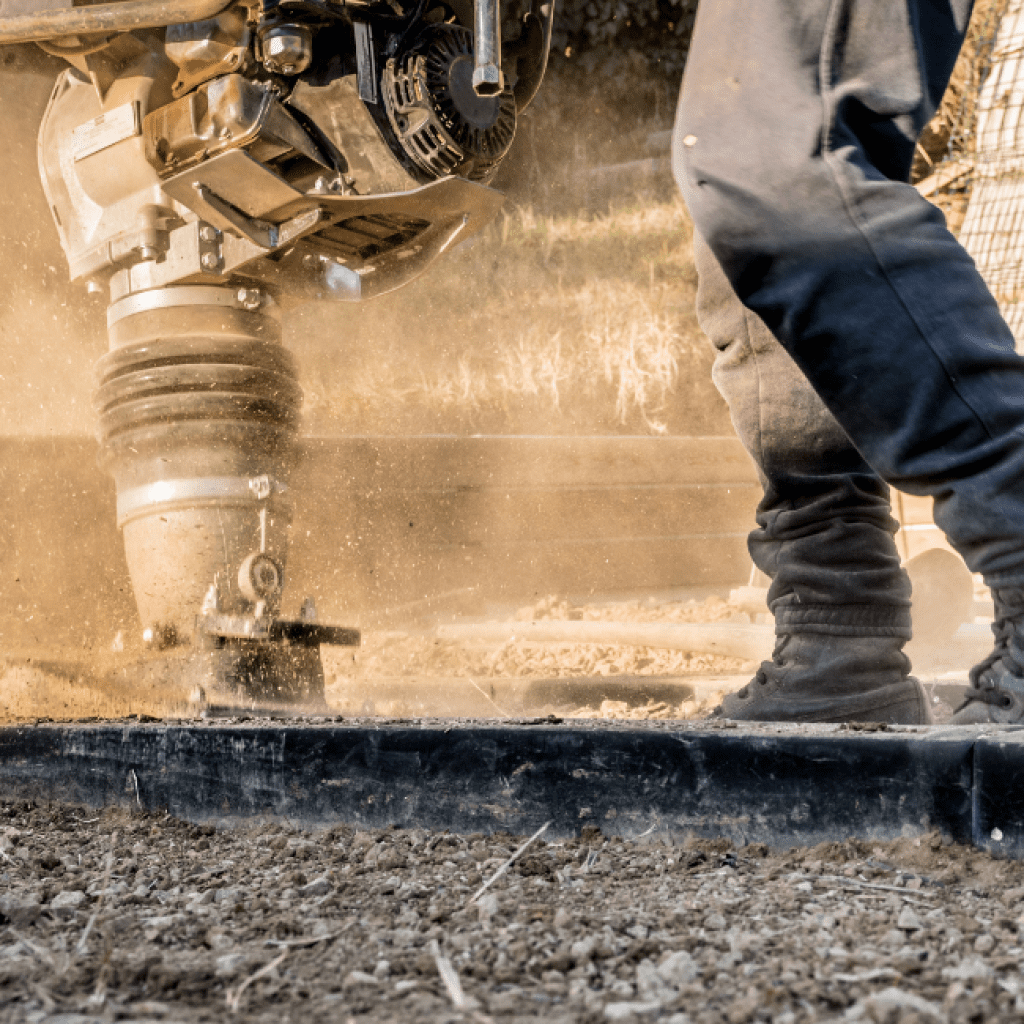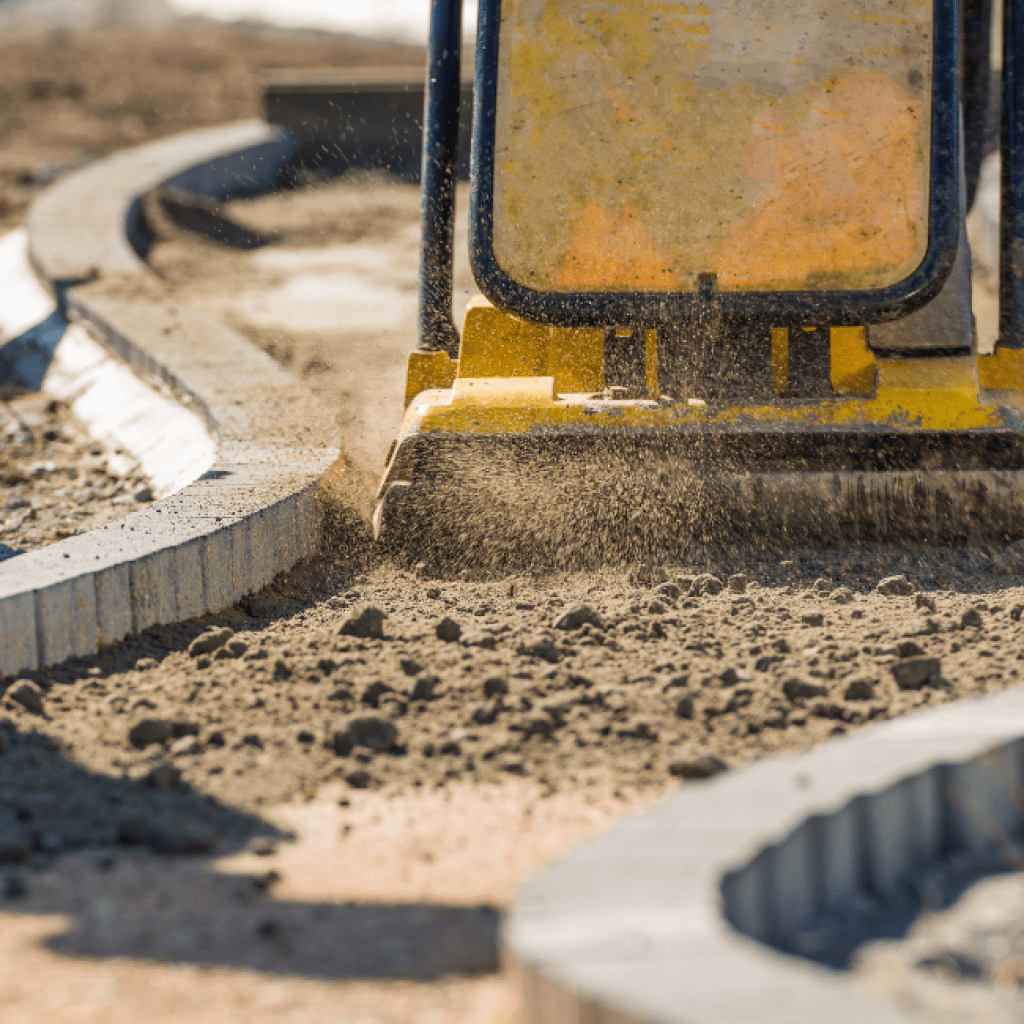
A successful construction project starts with a strong foundation. A strong foundation is built on level ground. Without a stable base to build on, even the tallest skyscrapers would come crashing down to earth, and beautiful landscapes wouldn’t have the chance to flourish.
Soil compaction is the process of pushing soil particles together to reduce the pore space between them. It makes for denser, stronger soil that has both less water infiltration and less water drainage.
Because soil compaction is so necessary, there are a number of compaction machines that are likely to turn up on your construction site. Two of the most common are vibe plate compactors (vibe plates) and vibratory rammer compactors (rammers). The choice between a vibe plate and a rammer is sometimes a difficult one. If you’re new to using compaction machines in general, you may wonder which tool is best for levelling the ground in your situation.
That’s why Ryno Hire is here to answer some common questions about vibe plate compactors and rammers. We’ll explain how each of these tools works, the differences between them, when to use each one and where to get your hands on decent models.
What Are Vibe Plates?
A vibe plate compactor is a machine that resembles a push-style lawnmower but has a heavy steel plate installed at its base. Powered by gas or diesel, vibe plates are incredibly versatile, adaptable machines. They’re relatively easy to use as far as construction equipment goes and can assist any project, from a simple suburban driveway to a residential highrise, a success.
How to use vibe plates
Because vibe plate compactors are versatile, you can choose the size of the base plate, the travel speed and the power of the equipment, depending on your project. Vibe plates are easy to use. Most come with pull-start motors and chokes, so all you have to do is turn the machine on and pull the cord to start the engine. While a vibe plate moves by itself, you still need to take control and push it in the direction you want it to go.
You can turn a vibe plate off by flipping the switch again. But be sure to let it cool down before moving it.

When to use a vibe plate
Vibe plates are best used on granular soil, in very large or flat areas, in trenches and in excavation sites because their easy manoeuvrability allows for precision.
What Are Rammers?
Vibratory rammers are machines that compact the soil using impact at high force. They strike the soil at around 500-750 blows per minute, squeezing out any air and water and making for dryer, denser soil. Rammers run on gas, diesel or electrical engines, and just like vibe plates, they can be used for many projects. From solid building foundations to stable roads to underground utilities and infrastructure, rammers consistently get the job done.
How to use rammers
Vibratory rammers come in various sizes, with attachment options made to suit the specifics of each construction site. Because the rammer is operated at an angle, the weight of the equipment plays a role in selecting the right one. The rammer’s manual will usually list the lift capacity—the amount of material that can be compacted at any one time—for each model.
The rammer’s controls are generally located on its handles, which the operator holds onto to move the machinery around. The bottom half of the rammer has a plate that connects with the soil, powered by the engine. The force of the rammer commonly strikes at 500-700 blows per minute.
When to use a rammer
Rammers are perfect when you’re dealing with cohesive soil, which includes a very high amount of clay. They’re ideal for soil that has a 13% moisture range, the kind of soil that doesn’t crumble or break up when dry.
Rammers also have a smaller size that enables them to squeeze into tight spots and make short work of smaller areas. It’s best to use a rammer on cohesive soil areas rather than on granular ones for decent results.
What’s The Difference: Vibe Plates Vs Rammers
It probably comes as no surprise that both vibe plates and rammers have their place on the construction site, and you and your team can benefit from both. The key difference between a rammer and a vibe plate lies in its method of compaction. A vibe plate condenses the soil through compaction, while a rammer does so by forcefully striking the ground.
A rammer also has an upright design, in contrast to a vibe plate compactor’s horizontal one. This can make the rammer a harder tool for amateurs to use than a vibe plate.
While vibe plates are widely considered to be less expensive to rent or buy than rammers, who you decide to hire from makes a big difference.
Dry Hire Compaction Equipment at Ryno Hire

When you need help deciding between different construction equipment, Ryno Hire can make a tough choice easier. With over a decade of experience in the earthmoving machinery industry, we know exactly what kind of gear a project requires.
Ryno Hire specialises in dry hire, which allows you to hire the equipment you need with only a current Australian open driver’s licence. You can hire from our range of DIY-operated dry hire equipment, including compaction equipment like rollers, rammers and vibe plates, for projects that last anywhere from a day to a year. Even if you’re new to using a compaction machine, we can provide you with instructions. Every dry hire comes with an operator’s manual, and you can always call us if you get stuck.
For all dry hire enquiries for construction projects large and small, contact the Ryno Hire team.
21 March 2024

